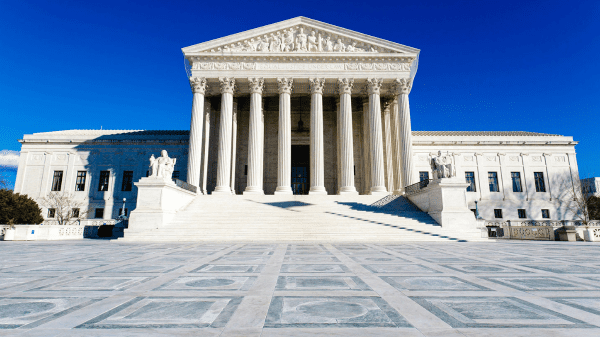
The big news of the day—at least in agricultural circles—is the long-awaited May 25 Supreme Court ruling in the highly publicized Sackett v. EPA suit, limiting Waters of the United States (WOTUS) regulation by the Environmental Protection Agency.
The court found that the meaning of the term “waters of the United States” (WOTUS) in the federal Clean Water Act covers “only those relatively permanent, standing or continuously flowing bodies of water ‘forming geographic[al] features’ that are described in ordinary parlance as ‘streams, oceans, rivers, and lakes.’”
The court decided that the federal Clean Water Act (CWA) doesn’t apply to wetlands that are merely “adjacent” to larger bodies of water (which are still covered by the act), but “have a continuous surface connection to bodies that are ‘waters of the United States’ in their own right,’ so that they are ‘indistinguishable’ from those waters,” wrote Justice Samuel Alito in the majority decision.
The 5-4 decision was, up to a point, unanimous. The dissenting judges agreed that the land of Chantell and Mike Sackett, in Priest Lake, ID, should not have been subject to the WOTUS rule, but held that the majority opinion went too far. Justice Brett Cavanaugh, writing a concurring opinion for the minority 4 justices, wrote that the new standard goes against 45 years of EPA practices and Supreme Court precedents. He contains that the CWA is mandated to protect both adjacent and adjoining wetlands, but the majority decision limits the protection merely to adjoining ones.
“By narrowing the Act’s coverage of wetlands to only adjoining wetlands, the Court’s new test will leave some long-regulated adjacent wetlands no longer covered by the Clean Water Act, with significant repercussions for water quality and flood control throughout the United States,” Kavanaugh says.
Agricultural interests by and large applauded the decision. American Farm Bureau Federation President Zippy Duvall commented, “AFBF appreciates the Supreme Court justices for their careful consideration of the implications of Sackett v. EPA. The EPA clearly overstepped its authority under the Clean Water Act by restricting private property owners from developing their land despite being far from the nearest navigable water.”
President Joe Biden expressed his disappointment with the ruling, commenting on Twitter: “The Supreme Court’s disappointing decision in Sackett v. EPA will take our country backwards—placing our Nation’s wetlands, and the rivers, lakes, and ponds connected to them, at risk of pollution and destruction. My team will work with the Department of Justice and relevant agencies to review this decision and use every legal authority we have to protect our nation’s waters for the people and communities that depend on them.”
“The narrowing of WOTUS, and therefore federal permitting jurisdiction, is an important victory for developers and the energy industry,” commented the National Law Review.
The big news of the day—at least in agricultural circles—is the long-awaited May 25 Supreme Court ruling in the highly publicized Sackett v. EPA suit, limiting Waters of the United States (WOTUS) regulation by the Environmental Protection Agency.
The court found that the meaning of the term “waters of the United States” (WOTUS) in the federal Clean Water Act covers “only those relatively permanent, standing or continuously flowing bodies of water ‘forming geographic[al] features’ that are described in ordinary parlance as ‘streams, oceans, rivers, and lakes.’”
The court decided that the federal Clean Water Act (CWA) doesn’t apply to wetlands that are merely “adjacent” to larger bodies of water (which are still covered by the act), but “have a continuous surface connection to bodies that are ‘waters of the United States’ in their own right,’ so that they are ‘indistinguishable’ from those waters,” wrote Justice Samuel Alito in the majority decision.
The 5-4 decision was, up to a point, unanimous. The dissenting judges agreed that the land of Chantell and Mike Sackett, in Priest Lake, ID, should not have been subject to the WOTUS rule, but held that the majority opinion went too far. Justice Brett Cavanaugh, writing a concurring opinion for the minority 4 justices, wrote that the new standard goes against 45 years of EPA practices and Supreme Court precedents. He contains that the CWA is mandated to protect both adjacent and adjoining wetlands, but the majority decision limits the protection merely to adjoining ones.
“By narrowing the Act’s coverage of wetlands to only adjoining wetlands, the Court’s new test will leave some long-regulated adjacent wetlands no longer covered by the Clean Water Act, with significant repercussions for water quality and flood control throughout the United States,” Kavanaugh says.
Agricultural interests by and large applauded the decision. American Farm Bureau Federation President Zippy Duvall commented, “AFBF appreciates the Supreme Court justices for their careful consideration of the implications of Sackett v. EPA. The EPA clearly overstepped its authority under the Clean Water Act by restricting private property owners from developing their land despite being far from the nearest navigable water.”
President Joe Biden expressed his disappointment with the ruling, commenting on Twitter: “The Supreme Court’s disappointing decision in Sackett v. EPA will take our country backwards—placing our Nation’s wetlands, and the rivers, lakes, and ponds connected to them, at risk of pollution and destruction. My team will work with the Department of Justice and relevant agencies to review this decision and use every legal authority we have to protect our nation’s waters for the people and communities that depend on them.”
“The narrowing of WOTUS, and therefore federal permitting jurisdiction, is an important victory for developers and the energy industry,” commented the National Law Review.
Richard Smoley, contributing editor for Blue Book Services, Inc., has more than 40 years of experience in magazine writing and editing, and is the former managing editor of California Farmer magazine. A graduate of Harvard and Oxford universities, he has published 12 books.



